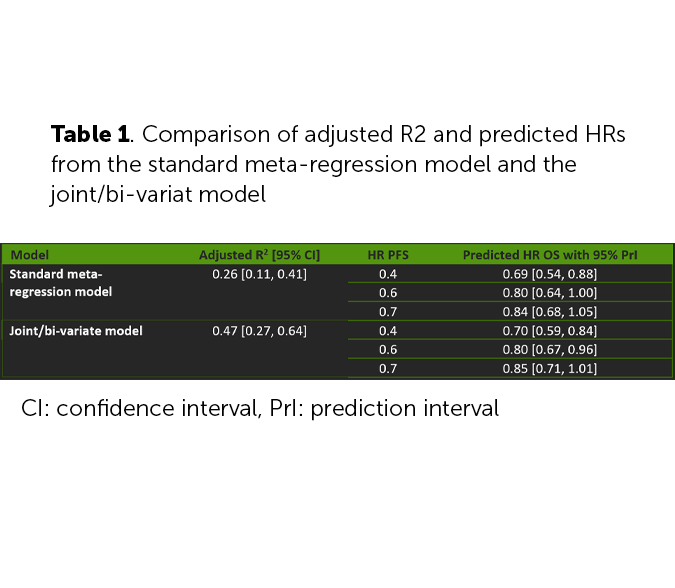Repurposed data and advanced analytics can be used to validate a surrogate endpoint. A surrogate endpoint is a substitute endpoint for a clinically meaningful endpoint in clinical trials. It is often used when it is impossible or very time-consuming to measure an intervention’s direct effect on morbidity or mortality. The validity of surrogate endpoints is based on their ability to predict the clinical outcome of interest reliably.1 Surrogacy, or the assessment of a surrogate endpoint as a measure of efficacy and safety for a particular drug class, is generally evaluated through randomized clinical trial (RCT) data.
By combining robust statistical methods with predictive modeling, drug developers can accurately assess the utility of a surrogate endpoint in predicting clinical outcomes.
Benefits
The analysis revealed that surrogacy strength depends on model parameterization and how well nonlinearities and collinearities are captured. Surrogacy strength substantially improves when using a joint or bi-variate meta-analytic model5 (as recommended in the recently updated NICE methodological guideline6) for the surrogate and the final endpoint, which can be seen in Table 1: the adjusted R2 (correlation coefficient) of the joint model increased to 0.47 as compared to the one of the standard meta-regression model. In addition, while joint modelling does not impact mean predictions, it led to narrower prediction intervals compared to those based on the standard meta-regression model, see the last column of Table 1.
The study demonstrated the importance of considering these components when predicting a surrogate’s performance. The client was able to use these findings to gain valuable insights into the potential of developing an effective surrogate modeling strategy.

- Surrogate Endpoint Resources for Drug and Biologic Development. US Food & Drug Administration. https://www.fda.gov/drugs/development-resources/surrogate-endpoint-resources-drug-and-biologic-development
- Blumenthal GM, Karuri SW, Zhang H, et al. Overall response rate, progression-free survival, and overall survival with targeted and standard therapies in advanced non-small-cell lung cancer: US Food and Drug Administration trial-level and patient-level analyses. J Clin Oncol Off J Am Soc Clin Oncol. 2015;33(9):1008-1014. doi:10.1200/ JCO.2014.59.0489
- Clarke JM, Wang X, Ready NE. Surrogate clinical endpoints to predict overall survival in non-small cell lung cancer trials-are we in a new era? Transl Lung Cancer Res. 2015;4(6):804-808. doi:10.3978/j.issn.2218-6751.2015.05.03
- Ma Y, Wang Q, Dong Q, Zhan L, Zhang J. How to differentiate pseudoprogression from true progression in cancer patients treated with immunotherapy. Am J Cancer Res. 2019;9(8):1546-1553.
- Papanikos T, Thompson JR, Abrams KR, et al. Bayesian hierarchical meta‐analytic methods for modeling surrogate relationships that vary across treatment classes using aggregate data. Stat Med. 2020;39(8):1103-1124. doi:10.1002/sim.8465
- Welton NJ, Phillippo DM, Owen R, et al. CHTE2020 Sources and Synthesis of Evidence; Update to Evidence Synthesis Methods.; 2020. https://www.sheffield.ac.uk/sites/default/files/2022-02/CHTE-2020_final_20April2020_final.pdf
- Wheaton L, Papanikos A, Thomas A, Bujkiewicz S. Using Bayesian Evidence Synthesis Methods to Incorporate Real World Evidence in Surrogate Endpoint Evaluation. Published online December 16, 2021. Accessed 14 December 2022. https://arxiv.org/pdf/2112.08948.pdf
Contact us





